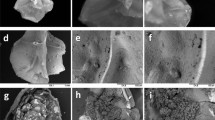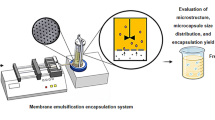Abstract
Solid fat beads containing aqueous droplets of either a water soluble dye (Brilliant Blue) or a suspension of viable probiotic bacteria (Bifidobacterium animalis ssp lactis) were produced by dropping a water-in-molten fat emulsion into cold water or onto a cold plate, respectively. Hydrogenated palm stearin beads containing 20 % dye solution were 4.6 ± 0.2 × 2.7 ± 0.4 mm and the average bead weighed 0.0103 ± 0.0003 g. The dye was completely released into an external aqueous phase after 24 h stirring at temperatures above the melting point of the fat but at temperatures where the fat was solid very little dye was released into an external aqueous phase. When a bacterial suspension was used as the internal phase of 20 % hydrogenated palm stearin/80 % palm kernel oil beads, the beads contained 8.44 log CFU/g. The encapsulated organisms were more resistant to acid stress than an unencapsulated control (loss of 0.7 versus 5.75 log CFU/g). This approach offers a way to protect probiotic bacteria during transit through the stomach. Practical application: by encapsulating bacteria in solid fat they become more resistant to acids. Small beads could be added to foods or swallowed as a pill as a way to deliver viable probiotic organisms to the lower digestive tract.






Similar content being viewed by others
References
Joint FAO/WHO Working Group Report on Drafting Guidelines for the Evaluation of Probiotics in Food. London, Ontario, Canada, April 30 and May 1, 2002. http://www.who.int/foodsafety/fs_management/en/probiotic_guidelines.pdf Accessed 27 October 2014
Salminen S, Nybom S, Meriluoto J et al. (2010) Interaction of probiotics and pathogens––benefits to human health? Curr Opin Biotechnol 21:157–167. doi:10.1016/j.copbio.2010.03.016
Rizzardini G, Eskesen D, Calder PC et al. (2012) Evaluation of the immune benefits of two probiotic strains B. animalis ssp. lactis, BB-12® and Lactobacillus paracasei ssp. paracasei, L. casei 431® in an influenza vaccination model: a randomised, double-blind, placebo-controlled study. Br J Nutr 107:876–884. doi:10.1017/S000711451100420X
Kajander K, Myllyluoma E, Rajilić-Stojanović M et al. (2008) Clinical trial: multispecies probiotic supplementation alleviates the symptoms of irritable bowel syndrome and stabilizes intestinal microbiota. Aliment Pharmacol Ther 27:48–57. doi:10.1111/j.1365-2036.2007.03542.x
Leyer GJ, Li S, Mubasher ME et al. (2009) Probiotic effects on cold and influenza-like symptom incidence and duration in children. Pediatrics 124:e172–e179. doi:10.1542/peds.2008-2666
Charteris W, Kelly P (1998) Ingredient selection criteria for probiotic microorganisms in functional dairy foods. Int J Dairy Technol 51:123–136
Jia L, Shigwedha N, Mwandemele OD (2010) Use of D (acid)-, D (bile)-, z (acid)-, and z (bile)-values in evaluating Bifidobacteria with regard to stomach pH and bile salt sensitivity. J Food Sci 75:M14–M18. doi:10.1111/j.1750-3841.2009.01398.x
Riaz QUA, Masud T (2013) Recent trends and applications of encapsulating materials for probiotic stability. Crit Rev Food Sci Nutr 53:231–244
Favaro-Trindade CS, Heinemann RJB, Pedroso DL (2011) Developments in probiotic encapsulation. CAB Rev Perspect Agric Vetinary Sci Nutr Nat Resour 6:1–8
Ding WK, Shah NP (2009) Effect of various encapsulating materials on the stability of probiotic bacteria. J Food Sci 74:M100–M107. doi:10.1111/j.1750-3841.2009.01067.x
Lahtinen SJ, Ouwehand aC, Salminen SJ et al. (2007) Effect of starch- and lipid-based encapsulation on the culturability of two Bifidobacterium longum strains. Lett Appl Microbiol 44:500–505. doi:10.1111/j.1472-765X.2007.02110.x
Pedroso DDL, Thomazini M, Heinemann RJB, Favaro-Trindade CS (2012) Protection of Bifidobacterium lactis and Lactobacillus acidophilus by microencapsulation using spray-chilling. Int Dairy J 26:127–132. doi:10.1016/j.idairyj.2012.04.008
Possemiers S, Marzorati M, Verstraete W, Van de Wiele T (2010) Bacteria and chocolate: a successful combination for probiotic delivery. Int J Food Microbiol 141:97–103. doi:10.1016/j.ijfoodmicro.2010.03.008
Weiss J, Scherze I, Muschiolik G (2005) Polysaccharide gel with multiple emulsion. Food Hydrocoll 19:605–615. doi:10.1016/j.foohyd.2004.10.023
Braipson-Danthine S, Deroanne C (2004) Influence of SFC, microstructure and polymorphism on texture (hardness) of binary blends of fats involved in the preparation of industrial shortenings. Food Res Int 37:941–948. doi:10.1016/j.foodres.2004.06.003
Champagne CP, Raymond Y, Tompkins TA (2010) The determination of viable counts in probiotic cultures microencapsulated by spray-coating. Food Microbiol 27:1104–1111. doi:10.1016/j.fm.2010.07.017
Chittiprolu S (2009) Effect of starch spherulites on survival of bifidobacteria in the presence of acid or bile. pp 122
Lankaputhra WEV, Shah NP (1995) Survival of Lactobacillus acidophilus and Bifidobacterium spp. in the presence of acid and bile salts. Cult Dairy Prod J 30:2–7
Wang X, Brown I, Evans AJ, Conway PL (1999) The protective effects of high amylose maize (amylomaize) starch granules on the survival of Bifidobacterium spp. in the mouse intestinal tract. J Appl Microbiol 87:631–639
Ghosh S, Rousseau D (2011) Fat crystals and water-in-oil emulsion stability. Curr Opin Colloid Interface Sci 16:421–431. doi:10.1016/j.cocis.2011.06.006
Ding WK, Shah NP (2007) Acid, bile, and heat tolerance of free and microencapsulated probiotic bacteria. J Food Sci 72:M446–M450. doi:10.1111/j.1750-3841.2007.00565.x
Borges S, Barbosa J, Camilo R et al. (2012) Effects of encapsulation on the viability of probiotic strains exposed to lethal conditions. Int J Food Sci Technol 47:416–421. doi:10.1111/j.1365-2621.2011.02855.x
Chávarri M, Marañón I, Ares R et al. (2010) Microencapsulation of a probiotic and prebiotic in alginate-chitosan capsules improves survival in simulated gastro-intestinal conditions. Int J Food Microbiol 142:185–189. doi:10.1016/j.ijfoodmicro.2010.06.022
Wang Y, Corwin R, Jaramillo DP et al. (2010) Acceptability and digestibility of emulsions in a rat model: effects of solid fat content and lipid type. J Am Oil Chem Soc 88:235–241. doi:10.1007/s11746-010-1671-1
Acknowledgments
The work was supported under a Hatch grant from the Pennsylvania Experiment Station. We are grateful to the companies who donated supplies used in the study and to Prof. G.R. Ziegler for assistance with the NMR measurements.
Author information
Authors and Affiliations
Corresponding author
About this article
Cite this article
Wolfe, L.A., Roberts, R.F. & Coupland, J.N. Encapsulation of Aqueous Components in Solid Fat Beads: Studies of a Model Dye and a Probiotic Culture. J Am Oil Chem Soc 92, 87–94 (2015). https://doi.org/10.1007/s11746-014-2567-2
Received:
Revised:
Accepted:
Published:
Issue Date:
DOI: https://doi.org/10.1007/s11746-014-2567-2




